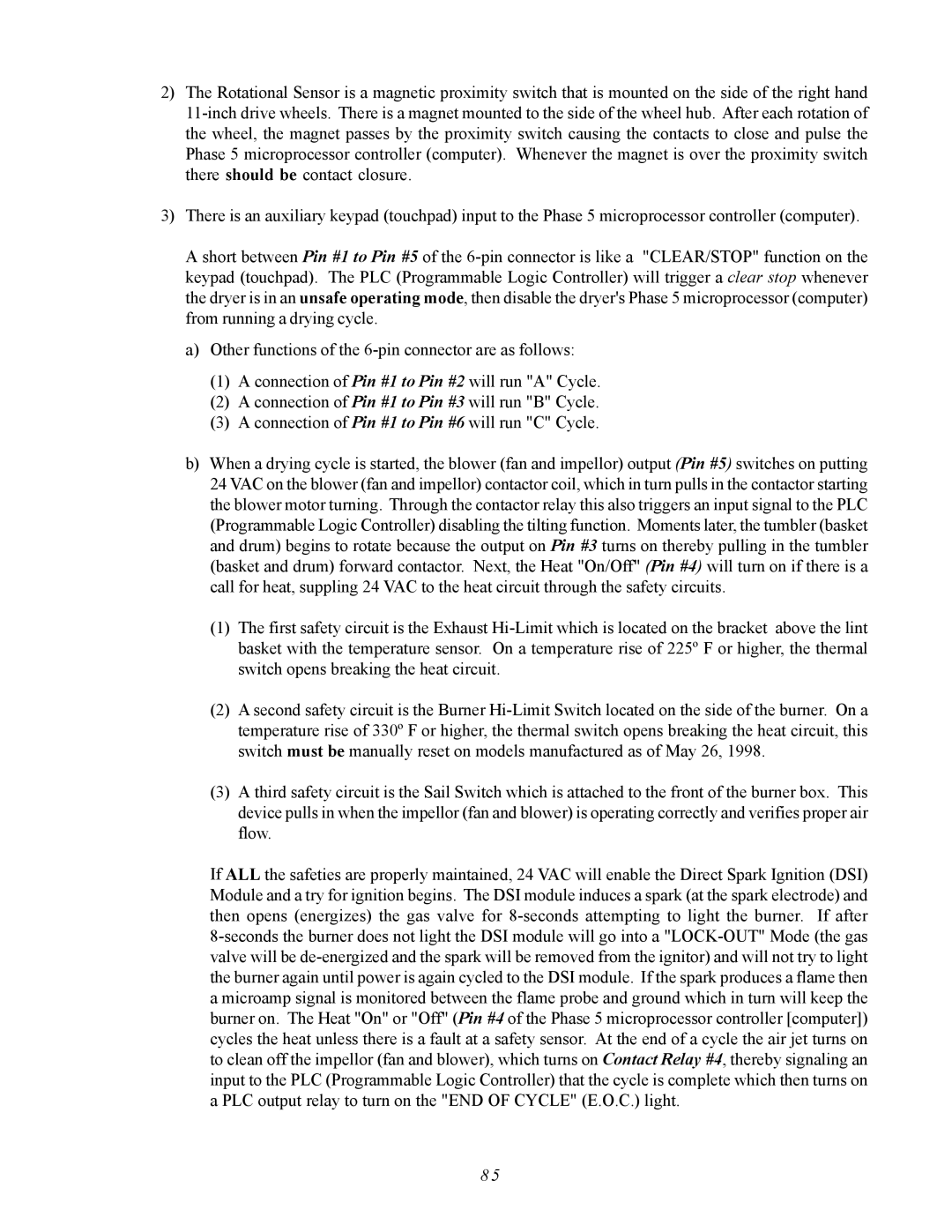2)The Rotational Sensor is a magnetic proximity switch that is mounted on the side of the right hand 11-inch drive wheels. There is a magnet mounted to the side of the wheel hub. After each rotation of the wheel, the magnet passes by the proximity switch causing the contacts to close and pulse the Phase 5 microprocessor controller (computer). Whenever the magnet is over the proximity switch there should be contact closure.
3)There is an auxiliary keypad (touchpad) input to the Phase 5 microprocessor controller (computer).
A short between Pin #1 to Pin #5 of the 6-pin connector is like a "CLEAR/STOP" function on the keypad (touchpad). The PLC (Programmable Logic Controller) will trigger a clear stop whenever the dryer is in an unsafe operating mode, then disable the dryer's Phase 5 microprocessor (computer) from running a drying cycle.
a)Other functions of the 6-pin connector are as follows:
(1)A connection of Pin #1 to Pin #2 will run "A" Cycle.
(2)A connection of Pin #1 to Pin #3 will run "B" Cycle.
(3)A connection of Pin #1 to Pin #6 will run "C" Cycle.
b)When a drying cycle is started, the blower (fan and impellor) output (Pin #5) switches on putting 24 VAC on the blower (fan and impellor) contactor coil, which in turn pulls in the contactor starting the blower motor turning. Through the contactor relay this also triggers an input signal to the PLC (Programmable Logic Controller) disabling the tilting function. Moments later, the tumbler (basket and drum) begins to rotate because the output on Pin #3 turns on thereby pulling in the tumbler (basket and drum) forward contactor. Next, the Heat "On/Off" (Pin #4) will turn on if there is a call for heat, suppling 24 VAC to the heat circuit through the safety circuits.
(1)The first safety circuit is the Exhaust Hi-Limit which is located on the bracket above the lint basket with the temperature sensor. On a temperature rise of 225º F or higher, the thermal switch opens breaking the heat circuit.
(2)A second safety circuit is the Burner Hi-Limit Switch located on the side of the burner. On a temperature rise of 330º F or higher, the thermal switch opens breaking the heat circuit, this switch must be manually reset on models manufactured as of May 26, 1998.
(3)A third safety circuit is the Sail Switch which is attached to the front of the burner box. This device pulls in when the impellor (fan and blower) is operating correctly and verifies proper air flow.
If ALL the safeties are properly maintained, 24 VAC will enable the Direct Spark Ignition (DSI) Module and a try for ignition begins. The DSI module induces a spark (at the spark electrode) and then opens (energizes) the gas valve for 8-seconds attempting to light the burner. If after 8-seconds the burner does not light the DSI module will go into a "LOCK-OUT" Mode (the gas valve will be de-energized and the spark will be removed from the ignitor) and will not try to light the burner again until power is again cycled to the DSI module. If the spark produces a flame then a microamp signal is monitored between the flame probe and ground which in turn will keep the burner on. The Heat "On" or "Off" (Pin #4 of the Phase 5 microprocessor controller [computer]) cycles the heat unless there is a fault at a safety sensor. At the end of a cycle the air jet turns on to clean off the impellor (fan and blower), which turns on Contact Relay #4, thereby signaling an input to the PLC (Programmable Logic Controller) that the cycle is complete which then turns on a PLC output relay to turn on the "END OF CYCLE" (E.O.C.) light.
